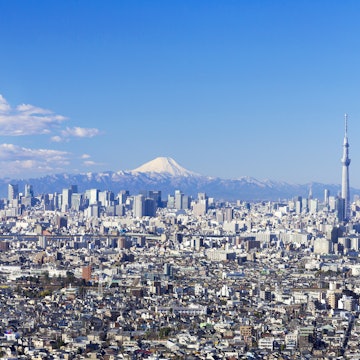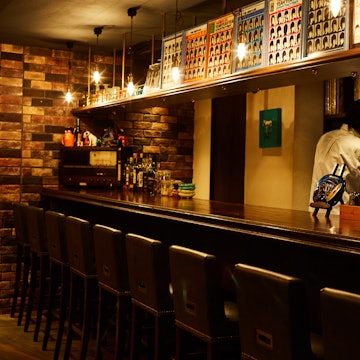

High-angle view of the Shibuya Scramble Crossing at night.
Tokyo is a huge, sprawling city that can seem impossible to tackle – especially when you’re short on time – but you can cover a lot with a little planning.
Here’s our plan for a short visit that hits both Tokyo's classic sights and local hotspots, and won’t have you running ragged all over the city.

Friday evening
Shinjuku is the natural place to start your exploration of Tokyo: with its skyscrapers, cacophony of glowing signs and heaving crowds, it’s become synonymous in the global imagination with the city itself. Get a feel for the enormity of the city from the (free!) observatory atop the Tokyo Metropolitan Government Building. For views in a (far, far) less institutional setting, go for cocktails at the chic New York Bar (get the check by 8pm to duck the ¥2500 cover charge).
There are many excellent dinner options in Shinjuku: Kozue (downstairs from New York Bar) for high-end traditional-meets-contemporary Japanese cuisine; Kanae for classic izakaya (Japanese pub-eatery) staples like tempura and sashimi paired with full-flavoured sake; and Omoide-yokochō, a traveller favourite, for cheap yakitori (grilled chicken skewers). Afterwards carry on over to Golden Gai, Shinjuku’s landmark collection of closet-sized bohemian bars in ramshackle wooden buildings.

Saturday morning
Ease into Saturday in Harajuku. The weekend Farmer's Market @UNU draws some of the city’s best food and coffee trucks and has outside tables for casual brunching. Another great option is a picnic in Yoyogi-kōen, Tokyoites’ favourite green space. If you enter the park from the west entrance (nearest subway stop: Yoyogi-kōen) you can pick up coffee from Little Nap Coffee Stand and Portuguese-style pastries from Nata de Cristiano. On most weekends during the warmer months, there are festivals at the plaza across from the park with accompanying food vendors (though quality can be hit or miss).

Saturday afternoon
It can be tempting to spend the whole afternoon lazing around the park, but there is a lot to do in Harajuku if you’re keen for more active adventures. At the very least, you have to go to Meiji-jingū, the city’s signature shrine, a grand wooden building set in a wooded grove.
The neighbourhood is equally famous for shopping, and you can pick up items from Japanese designers at spots like Laforet and House @Mikiri Hassin. There’s also some excellent, small museums here, too – perfect for a taste of classical Japanese art. The Ukiyo-e Ōta Memorial Museum of Art specialises in ukiyo-e (woodblock prints) while the Nezu Museum is focused on antiquities (and has a pretty strolling garden in the back). Feeling a little worn out? Take a break, and learn more about Japanese tea at Sakurai Japanese Tea Experience (reservations recommended).

Saturday evening
From Harajuku, it’s a short walk south to Shibuya, home to Shibuya Crossing – the city’s famously manic scramble intersection. It’s a top Tokyo photo-op, but rather than entangle yourself in the scores of people weaving their way over the crossing, head up to Mag’s Park, a rooftop space created specially for getting that perfect overhead shot.
For dinner, d47 Shokudō is an easy choice. It’s reasonably priced and is located inside the towering Hikarie building (which is easy to spot even in the biggest of crowds); it serves regional specialities from all 47 of Japan’s prefectures. Like Shinjuku, Shibuya is a nightlife and entertainment district with plenty going on in the evening, including popular nightclubs, like Contact and Circus Tokyo – which really get going after 11pm – and karaoke parlours, like Karaoke Rainbow, that stay open all night. If you’re in the mood for something more low-key, walk down the Kamiyama-chō market street to hip Tomigaya, a sub-neighbourhood of Shibuya known for its bistros and cafes. Here locals vie for tables at Pignon, while nearby Fuglen Tokyo does excellent, creative cocktails.

Sunday morning
Having gotten your fix of Tokyo’s more modern delights, spend your last day of the weekend getting acquainted with the city’s more traditional east side. Yanaka is one of the city’s rare neighbourhoods that retains many early 20th-century wooden buildings, some of which now house cafes, boutiques and ateliers. It’s equally popular with locals and tourists.
Start your morning at Kayaba Coffee, a classic kissa (first-wave coffee shop). Once happily caffeinated, stroll – admiring the miscellany of tiny temples en route – in the direction of Yanaka Ginza, a mid-20th century market street. Also worth a visit here: the Asakura Museum of Sculpture, which is among the city’s most charming, underrated spots and a fascinating example of the east-meets-west architecture that was in vogue in early 20th-century Tokyo.

Sunday afternoon
You can walk from Yanaka to Ueno-kōen (or take the Yamanote line two stops from Nishi-Nippori to Ueno), a sprawling space with many cultural attractions. See the gilded shrine Ueno Tōshō-gū (so different from sombre Meiji-jingū!) and the weather-worn temple Kiyomizu Kannon-dō, which dates from the 17th century.
In summer, the park’s pond, Shinobazu-ike, is covered in flowering lily pads. Inside the park, Innsyoutei is a wonderful place to treat yourself to a kaiseki (traditional Japanese haute cuisine) lunch. The prices are not unreasonable and the setting, a 19th-century wooden building with a garden, is beautiful (as is the food presentation); reservations recommended. Sundays in Ueno-kōen also attract food carts and street performers. Before heading back to the station, consider having a quick browse for unusual souvenirs at Ameya-yokochō; formerly a WWII black market and now home to a collection of eclectic stalls – which of your friends wouldn’t love a flamboyant silk bomber jacket from specialist Ōkuma Shōkai?

Where to stay
Shinjuku: This popular base on the city’s west side has a huge spread of accommodations from almost-budget to deluxe and also boasts direct access to Narita airport via both train and bus. Basic business hotels, like Hotel Sunroute Plaza Shinjuku, are the best value. For high-end digs you can’t beat the Park Hyatt Tokyo. 9 Hours Shinjuku-North, a contemporary capsule hotel one station north of Shinjuku, is a good option if you’re willing to give up a little comfort and convenience in order to save some yen.
Ueno: This is the biggest hub on Tokyo’s east side, closer to Narita Airport (also with direct train access) and coming in a little cheaper than Shinjuku. New in 2018, Nohga Hotel is a solid choice. In neighbouring Yanaka, there is a great guesthouse, hanare, and a wonderful, family-run ryokan (traditional Japanese inn), Sawanoya Ryokan.
















